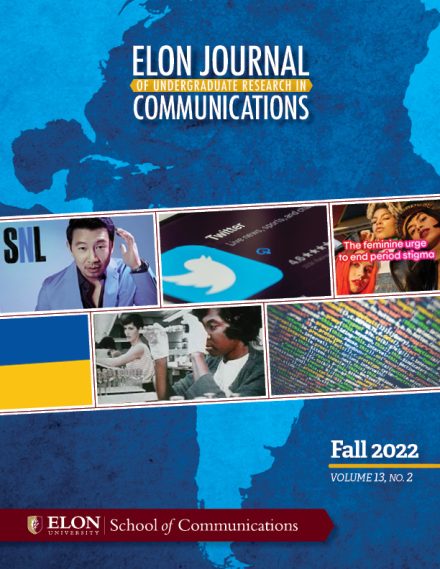In the most recent edition of the Elon Journal, seven student researchers conducted an expansive look into a variety of media-related topics, including geopolitics and gender.
The School of Communications has published the fall 2022 issue of the Elon Journal of Undergraduate Research in Communications, featuring student research on topics ranging from global newspaper coverage of the Russian invasion of Ukraine to an examination of Richard Nixon’s television campaign ads during his 1968 presidential campaign.

The issue contains seven research papers authored by School of Communications students, with geopolitics and gender serving as the issue’s dominant themes, according to Professor Harlen Makemson, who serves as the journal’s editor.
Three student researchers used qualitative content analysis in very different ways to understand political events both past and present. Katie Dalrymple opens the journal with an analysis of Richard Nixon’s television campaign ads from his 1968 presidential campaign. She utilized “videostyle” analysis to demonstrate how video production elements augmented his language surrounding dog whistle racism.
Christian Harrison focused his research on a more recent campaign, studying how Twitter was used during the 2020 U.S. Senate race in Georgia. His article concluded that the candidates most frequently utilized the social media platform for non-issue-related communication such as fundraising.
Additionally, Elise Leary-Forrey examined the early days of the Russian invasion of Ukraine through global newspaper coverage, finding that U.S. headlines tended to have more of an economic focus, while international headlines stressed the military angle.
Three other student scholars applied various approaches to study gender, including two articles that examined gender through an advertising context. Anna Sutton concluded that hard seltzer television ads are less likely to exhibit stereotypical gender archetypes than are beer ads, while Claire Grider concluded that social media ads for menstrual products have moved away from messages that communicate shame and more toward inclusiveness.
Meanwhile, Corinne Rose applied feminist standpoint theory through in-depth interviews with professionals to explore how women in the data and communications fields experience discrimination.
Lastly, Molly Healy investigated representation through “Saturday Night Live,” comparing how the use of stereotypes and satirical racial humor varied over four episodes of the long-running NBC comedy show that featured Chinese guest hosts.
For this fall 2022 issue, Makemson assembled an editorial board of nearly 30 communications faculty members who participated in the multiple blind-review process to select the best student work.
The Elon Journal began in spring 2010, with spring and fall editions each year. The fall 2022 journal marks its 26th edition.
The Council on Undergraduate Research catalogs more than 200 student research journals in the nation, and the Elon Journal is one of the few that focuses on undergraduate student research in journalism, media and communications.


